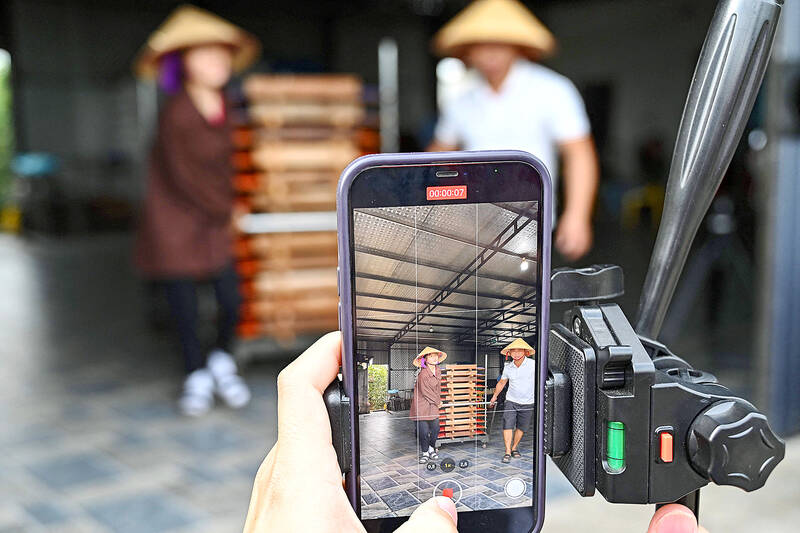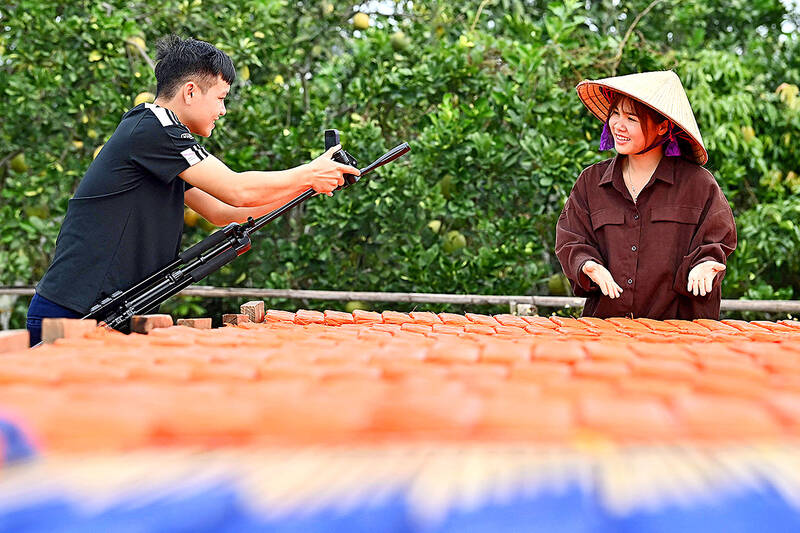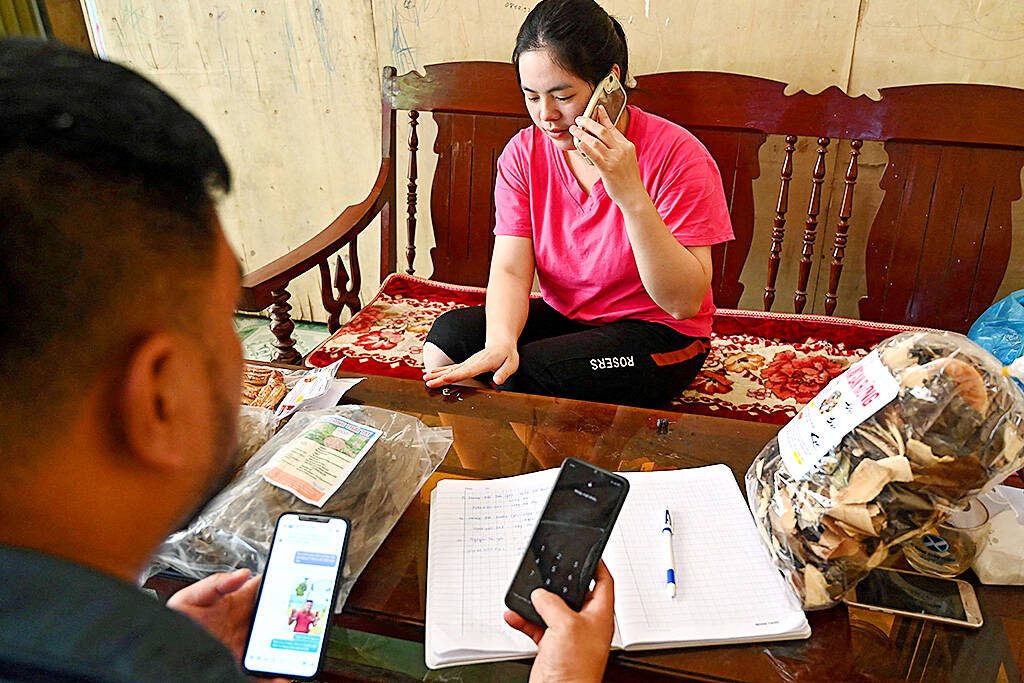Vi Thi Anh spent half a decade doing monotonous low-paid work in industrial hubs near Vietnam’s capital Hanoi, assembling mobile phones for global electronics companies including Samsung. Then she discovered she could earn vastly more hawking food products to thousands of followers as one of the country’s growing cadre of TikTok livestreamers.
Communist Vietnam’s supply of cheap labor has attracted some of the world’s top companies, but climbing salary expectations have enticed many young people to leap into the exploding business of social commerce — whether to boost their incomes or to extricate themselves from dead-end jobs.
Anh, 23, said she earned just US$400 per month in her “boring” factory job, barely enough to cover her rent and food, before she was laid off in 2021 thanks to falling orders from the West. She found another factory job, but soon “turned to full-time livestreaming so I could earn more for my family,” Anh said, the thick rice noodles she sells online laid out behind her, drying in the sun.

Photo: AFP
On her TikTok channel, which has over 350,000 followers and 15 million likes, orders fly in for the US$4 noodle packs, made by her uncle.
“This pack of noodles is so colorful, but completely safe and delicious,” Anh tells her audience, pointing to red, yellow and purple bundles. Between June and September this year, more than 118,000 people, mostly in the garment and footwear sector, lost their jobs in Vietnam, according to official figures.
At her home in northern Bac Giang province, Anh said that like she did, workers fear “that if they are laid off, they have no way of earning a living.”

Photo: AFP
Livestreaming, she said, offers a way to ease that worry.
BOOMING E-COMMERCE
Nearly 80 percent of Vietnam’s 100 million people have access to the Internet, and according to a recent survey by the data agency Statista, a similarly high percentage of Gen Z use TikTok.

Photo: AFP
“Farmers, workers and students can easily start their own channels,” said Nguyen Doan Ky, co-founder of the DC 3 Do agency, which offers social media and livestreaming services.
“Online selling used to be only for businesses or shop owners. Now it is an opportunity for everyone.”
As in neighboring China, where farmers are making big money on TikTok, e-commerce is booming in Vietnam, with sales growth averaging 30 percent year over year for the last decade. Vietnam is one of the world’s top 10 growth markets and turnover is expected to reach more than US$20 billion this year, according to the ministry of industry and trade.
Coming from the country’s rural and mountainous north, Luong Quang Dai never imagined he would become an influencer with 420,000 followers online.
He earns 10 times as much as he did before livestreaming thanks to his popularity on Tiktok and Facebook, selling dried bananas, vermicelli noodles and a tea mix made in his neighborhood.
“We can save up to 100 million dong per month (US$4,000) and at the same time help create jobs and a stable income for relatives and friends,” the 33-year-old said from his farmhouse in the forests of Bac Kan province.
In his youth, Dai spent two years trying to find a route out of the hard, spare life of a farmer, moving to the city in a familiar story of urban migration. But failing to earn enough for even basic necessities, he returned to his home in the countryside, where two-thirds of Vietnamese still live. In addition to farming, he began to post videos on social media of him and his wife feeding chickens and harvesting bamboo in the depths of the forest.
The simplicity of the posts soon earned him an enormous following, and he began to sell his produce in huge quantities.
“Social media has changed my life completely,” Dai told AFP.
’DIGITAL FARMER’
Tran Thanh Nam, an education psychology expert, cautioned that although social commerce has become popular, TikTokers needed to keep updating their skill sets. “Businesses that take off in a short space of time... can also turn into failures quickly,” he said.
But he understood the appeal, he added.
“Becoming a worker in a factory or industrial zone is a way to use up all one’s youth and health... and they lose a lot of other opportunities.”
According to state media, on TikTok alone there were 30 training programs on digital transformation that last year attracted thousands of learners. Among other blue-collar workers to have found an audience and a decent income is Loc Fuho — a former builder with 2.5 million followers who livestreams lessons in masonry and plastering.
Dai is still happy to be a farmer, “but a digital one,” who has influence and a good income.
“I expect nothing more,” Dai said.

On April 26, The Lancet published a letter from two doctors at Taichung-based China Medical University Hospital (CMUH) warning that “Taiwan’s Health Care System is on the Brink of Collapse.” The authors said that “Years of policy inaction and mismanagement of resources have led to the National Health Insurance system operating under unsustainable conditions.” The pushback was immediate. Errors in the paper were quickly identified and publicized, to discredit the authors (the hospital apologized). CNA reported that CMUH said the letter described Taiwan in 2021 as having 62 nurses per 10,000 people, when the correct number was 78 nurses per 10,000

As Donald Trump’s executive order in March led to the shuttering of Voice of America (VOA) — the global broadcaster whose roots date back to the fight against Nazi propaganda — he quickly attracted support from figures not used to aligning themselves with any US administration. Trump had ordered the US Agency for Global Media, the federal agency that funds VOA and other groups promoting independent journalism overseas, to be “eliminated to the maximum extent consistent with applicable law.” The decision suddenly halted programming in 49 languages to more than 425 million people. In Moscow, Margarita Simonyan, the hardline editor-in-chief of the

Six weeks before I embarked on a research mission in Kyoto, I was sitting alone at a bar counter in Melbourne. Next to me, a woman was bragging loudly to a friend: She, too, was heading to Kyoto, I quickly discerned. Except her trip was in four months. And she’d just pulled an all-nighter booking restaurant reservations. As I snooped on the conversation, I broke out in a sweat, panicking because I’d yet to secure a single table. Then I remembered: Eating well in Japan is absolutely not something to lose sleep over. It’s true that the best-known institutions book up faster

Though the total area of Penghu isn’t that large, exploring all of it — including its numerous outlying islands — could easily take a couple of weeks. The most remote township accessible by road from Magong City (馬公市) is Siyu (西嶼鄉), and this place alone deserves at least two days to fully appreciate. Whether it’s beaches, architecture, museums, snacks, sunrises or sunsets that attract you, Siyu has something for everyone. Though only 5km from Magong by sea, no ferry service currently exists and it must be reached by a long circuitous route around the main island of Penghu, with the